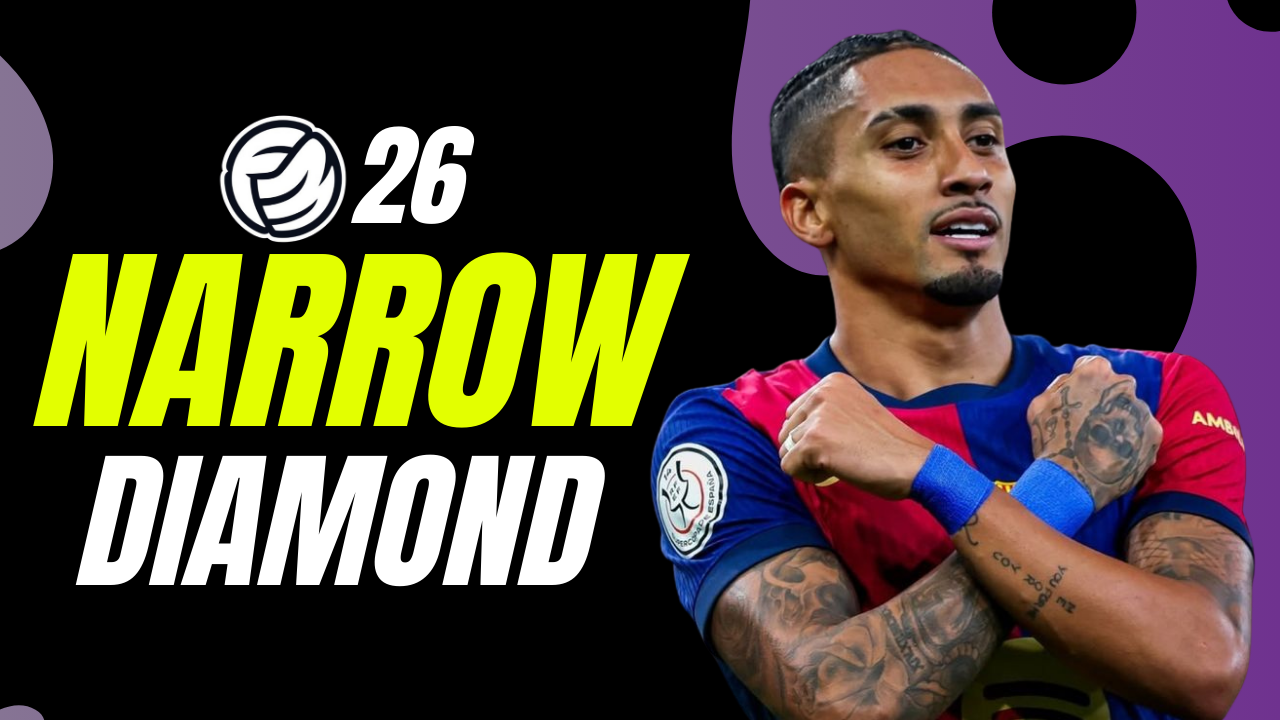
You cannot deny the entry without reducing the time and space the opponent has to access it, at the same time you cannot reduce space without allowing easy entry into a certain area.
Ideally to stop conceding you want the opponent as far from goal as possible whilst taking as many touches as possible for an individual to get there.
This means if a CB or Goalkeeper wants to dribble forward and shoot so be it, or if a player wants to shoot from a great distance then that is fine.
The reason is that if the opponent takes these chances then a huge majority will fail.
Stopping these chances almost always means giving away entry or space in an area closer to goal but it also means you get the ball quicker.
Formations
The most important thing that determines how you defend is your formation. The reason is there are fewer ways to manipulate how you defend as compared to how you attack.
Some roles do have unique ways to defend, the half-back who essentially is a centerback that operates as a DM offensively.
The Pressing Forward on Defend acts as a Ball winner upfront. Defensive Winger as well who presses opposing fullbacks but works hard to defend the flanks.
The field is big and very few formations cover all the areas near goal and so it is important to know what areas are vulnerable. The more aggressive formations have lots of issues defensively that leave them vulnerable.
Goals can come from anywhere and the idea is to only allow opportunities to come from positions that favour your defence.
XG
So it's obvious that there are certain things we cannot do in football.
We for example cannot stop any team from getting at least one shot at goal. Often teams, especially teams that play fast-paced will get at least one or two good shots in.
It also then applies that if we cannot deny the opponent from a single shot, then of course we cannot make sure we don't ever concede.
This understanding is what creates the famous FMed meme where you lose to a single shot on target.
So we need a system that determines how good our defence is. We look at XG and once again XG is not the be-all, end-all but it is a good way to see if we have a solid defence.
The Zones
There are two important zones that you need to think about in FM.
The first is the zone in front of the defence, and the next is the zone behind the defence.
Protecting these zones is important because the space behind defence leads to one v one which may not hurt you in this game but it will hurt you the next game.
It is also likely that not protecting this area will force the center backs out of position chasing the ball, forcing midfielder to cover for them and leaving space in front of the defence, the second zone.
Not protecting the front of the defence leads to long shots which again is something that will inconsistently punish you.
It can cause issues in the other zone, where if that space is accessible the defenders may choose to close down creating space behind.
To make your defence consistent you need to protect *both* of these areas and to do so you need players who will be responsible for these areas or instructions to somewhat mitigate these issues.
The Zone in front of Defence (Golden Zone) (Mid Block - more on this later)
How to Protect it:
- Lower pressing trigger
With your players denying entry, the opponent is forced to push the ball wide.
- Lower Line of Engagement
Your midfield limits space available, anyone trying to receive the ball in front of the backline will be under pressure from the midfield.
- High Defensive Line
Your defence limits space available, anyone trying to receive the ball in front of the backline will be under pressure from the defence.
- Playing formations with a DMC Position
It is important to reiterate that just putting a DMC provides decent cover in this zone. Even if the player plays a more offensive role, the defensive attributes required to play here will be regularly evaluated
- Playing MC position who prioritises *Denying* space (any defend duty player and the BBM)
Just because the LOE is low doesn't mean players will try to stop entry into this zone. It can be even more effective if someone positioning to intercept or stop players from accessing this area.
- No Stopper duty center back who *reduces* space in front of them
A high line may not be enough. Stoppers are a more aggressive group of defenders who will be better at covering the space in front of the defence.
There are a few important things to discuss. The first is that you don't need all these solutions to defend this area.
If you have a DMC without good defensive intelligence then it's already well covered. If not then you can reduce your LOE (this will force you to play a more counter-attacking strategy) or a high DLine (leaving the other zone vulnerable).
There is also the need to recognise the overall quality of your team, sometimes if you're not the best in your division or in that particular match then more resources need to be allocated to the protection of this zone.
This can include adding another defensive duty in midfield or reducing your pressing.
The best method is a formation change since it gives you more defensive cover without compromising your attack.
One example can be moving your MC to a DMC but keeping them as a DLP.
The Space in Behind (Split Block - more on this later)
How to protect it:
- Higher Pressing trigger
Putting Pressure on the opponent is the only way to stop them from trying to pick apart the defence, the less space for the opponent to play, the more random their passes forward are.
- Higher Line of Engagement
This works with the pressing scheme, allowing the midfield to be as close to the opposing team as possible.
- Lower Defensive Line
The more space behind your defence, the less skill/intelligence required to access it.
- Playing a Cover duty Center back or Libero
These roles both try to sweep up loose balls that may come from these passes. They have a higher defensive intelligence so there is less likelihood of unwanted surprises.
- Playing a Sweeper Keeper
Sweeper Keepers do well in the scenarios that occur when the space behind the defensive line is exposed. The ability in the one v one will still help reduce the number of goals conceded
- Pressing Roles (SS/MEZ/PF/BWM/DW)
These roles are specialists in chasing down deeper players and keeping them occupied.
Similarly to the previous section, it isn't necessary to employ every strategy here.
Something as simple as having a goalkeeper who excels at one v ones can make a big difference. If you have good press, then you may not need to worry too much about this.
If your Center backs have great defensive intelligence then it is probably well covered. Just like before quality also makes a difference, so the better your players then the more risks you can take with this aspect of your defence.
Protecting Both Zones
So with this understanding, you can see that protecting one zone often means exposing another which is why defending can get so difficult.
To solve this dilemma you need to pick your poison. This means determining which zone is less of a risk to keep slightly open.
Defensive power is important to keep in mind as well. What that means is the more players are given the duty of defending or helping the defence, the easier it is to cover both zones.
A good example is a back 3, which allows you to get away with space behind and in front of the defence.
Denying Space, Parking, Protecting Goal, The Low Block
This is the only way to protect both Zones, the way it works is Pressing/LOE/DLine are all low meaning no entry to any one of these areas. The other name for this is parking.
A few issues are playing this way. Most of them have to do with the attack (reliance on the counterattack or set pieces to score. Both are Low Percentage methods).
The biggest issue is the amount of pressure this creates, the opponent can now throw players forward without any worry of being vulnerable.
If the opponent does this from minute one then it's going to be a long game. If the opponent however is slow to realise the issue, then you may just steal a draw or a win.
Reducing Space, Pressing, Winning the ball, High Block
This is the aggressive method of defending and what matters is understanding the focus of this style is winning the ball at all costs. This of course means players will push into the opponent's half and will close down players on the ball.
It is aggressive, it's fast and it is vulnerable to the counter. This system needs mobile players, everywhere!. In this case, Pressing Intensity/LOE/DLine are all high meaning the opponent will have a hard time keeping the ball.
It is really risky but one thing is certain, you will get the ball back!.
The question is whether you will win it back, or concede and get it back at the Restart. This is the choice method for players who want to win every game they play because for some teams a draw isn't a good enough result.
Mid Block
This method of defence is for protecting the golden zone and puts a heavy priority on doing so.
The reason why it exists is simply to shut down teams that try to play through the midfield and have no real interest in trying to get in behind the defence.
To create a midblock you simply play a high line with a standard or lower LOE. You can also create this system by having certain players press more than others or you can have certain players press less.
Very important to understand that whilst I did say this before, having a DMC or players who are responsible for this area means this method of defence is overkill.
Formations that lack a DMC (like the famous 4231 or a simple 442) are the ones that can truly benefit from playing this way.
Split Block
This method is to stop teams that want to try and generate opportunities behind your defence. Its purpose is to force the opponents to play through the midfield and try to access the golden zone.
To create this system you only have to play a higher LOE with a lower DLine. Similarly, you can just adjust the pressing of specific players.
Just like before this system is unnecessary if you have a formation with a *great* DMC (433DM) then you can justify having everyone else focus on reducing space for deep playmakers on the ball while reducing space for deep playmakers to pass into.
If you don't have a great DM, then you can simply play multiple DMs (4222DM). It also works should you have multiple MC midfielders who are covering the golden zone.
The Goalkeeper
So one thing people don't often do is design their defence around their goalkeeper.
Goalkeepers have attributes that allow them to better deal with specific shots and fail with others.
This doesn't mean that a certain goalkeeper can never concede from a one v one but what it does mean more than anything is that you could reduce the goals you concede just a bit by looking at your goalkeeper and designing your defence accordingly.
To do that we simply have to establish which defensive style your goalkeeper prefers and why.
The Channels
There are 5 channels. These are the 2 flanks, the two half-spaces and the Center.
In the how-to attack guide, I talked about how a good offence can access all five.
Protecting all 5 channels, however, is a game-by-game thing unless you are playing a back 5. Back 5s are a good way to protect all 5 channels but that extra CB is coming from somewhere.
The next best solution is playing formations with the ML/R positions, this allows your team to protect the flanks.
Defend Wider
Defending wider aids the press, players higher up the field position closer to the flanks limit passing options. It does however open up entry into the zones through the half-spaces.
Playing a DM can help protect the zone in front of the defence (you can see how valuable a DM becomes).
If you ever choose to defend wide, I'd recommend you play a back 3 with your backline possessing particularly mobile players. That is acceleration and pace are important alongside some defensive intelligence.
It also is likely that a back 3 has only 2 players on each flank so flank protection is at a minimum. Playing wider can help with that issue as well.
Defend Narrower
Defend Narrow weakens the effectiveness of players higher up the pitch with the press. It however is a very good way of protecting both zones, in circumstances where a DM isn't present.
If you have a DM then it might still be worth it to give him some protection and not put a lot of pressure on him.
It also might not be necessary to go narrow since the opponent is likely playing direct and so staying standard to press a bit harder is likely better.
Another good reason to play Narrow is with a formation with good flank protection (442).
Get Stuck In / Stay on Feet
This part depends on your team. Getting stuck in is better for the press but makes it easier for players to mark your team.
Stay on feet means more solid one v one defending but relaxes the pressure on the opponent meaning they can be more aggressive in attack and not fear losing the ball.
The most important attributes to consider are physical attributes and work rate, as compared to positioning and intelligence.
Use Tighter Marking
This has the added effect of protecting both zones, particularly with a better quality team. In circumstances where your team is more physically capable than most in the division or your immediate opponent.
Tighter Marking means that access to the golden zone is increasingly difficult as well deeper players have little time and space to pick apart your defence.
Offside Trap
The offside trap is a very strong option for when you have a very good center back pairing. It allows your Center backs to protect both zones. When playing center backs on defend duty, turning this on means the space behind, is well protected.
This is assuming again that your center backs have a great level of defensive intelligence. On defend duty center backs are also able to put some pressure on players who get the ball in the golden zone.
Good Defensive setups
In this section, there are examples of good well balanced defensive setups. One such example is a back 3.
You may play a back 3 but feel the need to press, if your CBs are reasonably quick (retraining players who can play WB to CB is one way to get mobile CBs) then you can still have a good press by defending wider.
One thing you don't want to do is defend narrow since you cannot likely press as well as other systems. This is all assuming you want to be a high block, high pressing team. Low block systems with the back 3 want a narrow defence assuming there is no DM.
A 442 is also another system with a better level of defensive protection. The wide midfielders mean there will be better protection of the flanks, and so going narrow in defence is a good idea. This will however reduce the pressing power which isn't a big issue since the counterattack potential with 2 strikers is high.
The 4231 is more of a pressing system but can also be played like a midblock. In a midblock, the 4231 makes up for the lack of DM and can use individual pressing instructions to keep the press of the front players.
The 433 has a DM already and is very malleable, able to play as a high, split or even low block. The most interesting version of this is the high block since, in this system, one great DM means everything can be turned up to the max with pressing intensity and LOE.
The best defence
There is no such thing as the perfect defence since the more players you defend with, the more the opponent can send players forward.
The reason why being defensive is the go-to strategy for weaker teams is that a draw is a reasonable result. The better your quality the more defence matters little.
It is important to design schemes with the overall quality of your team in mind.
Here is a list of the attribute combinations.
ATTACK
Consistency - Applies to all events when attacking
- Composure
- First Touch
- Teamwork
- Decisions
Mobility
- Acceleration
- Agility
- Pace
Physicality
- Strength
- Balance
Passing Ability
- Passing
- Technique
Dribbling Ability
- Dribbling
- Technique
- Mobility
Crossing Ability
- Crossing
- Technique
Hold up play
- Physicality
- Consistency
Creativity
- Anticipation
- Vision
- Flair
- Passing and or Crossing and or Dribbling
Opportunity Seeking / Finding Space
- Off the Ball
- Anticipation
- Decisions
Shooting
- Finishing
- Long Shots
- Technique
Heading
- Heading
- Technique
Chance Taking
- Composure
- Heading and or Shooting
DEFENSE
Aerial Ability
- Jumping Reach
- Bravery
Endeavour
- Work Rate
- Aggression
Focus
- Composure
- Concentration
Defensive Awareness
- Anticipation
- Decisions
- Positioning
Off Ball Defending
- Focus
- Defensive Awareness
- Marking
- Mobility and or Physicality
On-Ball Defending
- Endeavour
- Defensive Awareness
- Tackling
- Mobility and or Physicality
Feel free to share your thoughts in the comments. You can also find me on reddit.






![TinyHips' Dark Mode Skin v5.2 [Win + MacOS] *UPDATED 26.1.0*](assets/downloads/fm26/fm26-dark-mode-skin.th.png)


![FM26 Data Tweaks [v1.1 | v1.6]](assets/downloads/fm26/fm26-data-tweaks-by-sirtavares-v2.th.png)

Discussion: How to Defend in Football Manager
No comments have been posted yet..